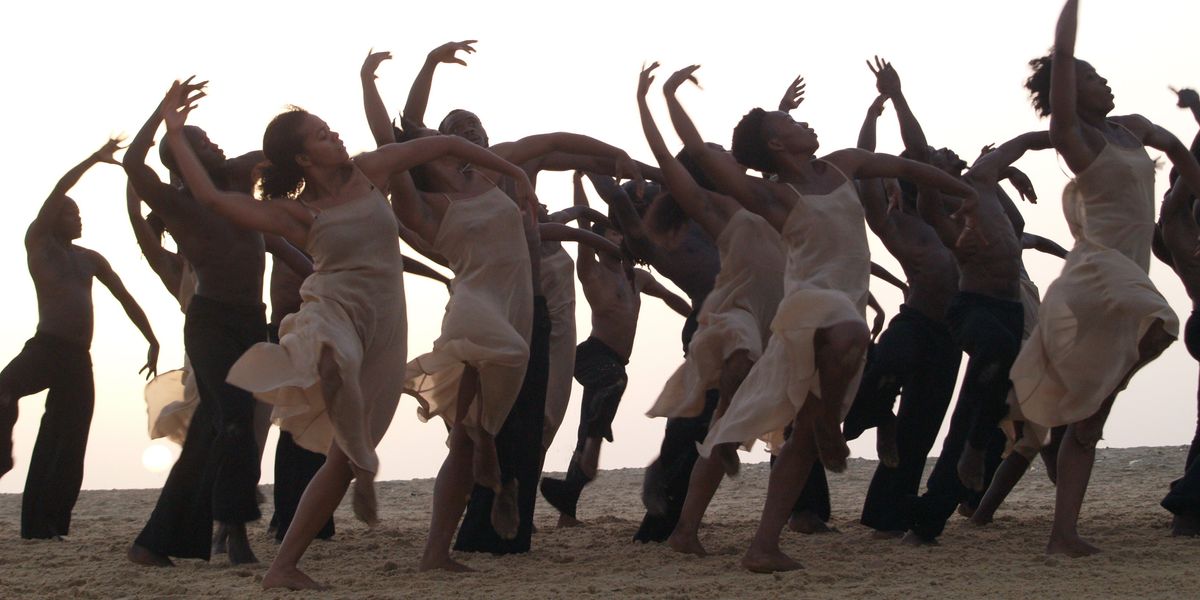This Breathtaking Film Captures 38 African Dancers Performing Pina Bausch's Rite of Spring
Known as the “mother of contemporary African dance,” Senegalese-French dancer and choreographer Germaine Acogny first saw Pina Bausch’s The Rite of Spring performed by dancers of the Paris Opéra Ballet. Presented with the tale of human sacrifice and gender relationships, she couldn’t help but draw parallels between the ritualistic choreography and traditions from her African homeland.
“In Africa, as well as in European cultures such as ancient Greece, it was quite usual to sacrifice young, female virgins to obtain something from the gods,” says Acogny, translated by her husband Helmut Vogt from their home an hour outside of Dakar, Senegal. “For me, seeing The Rite of Spring highlighted historical, cultural similarities between Africa and Europe. I thought that if it were to be danced by a group of African dancers, it would bring a very special energy to the piece.”
Acogny had previously worked with the famous Stravinsky score, winning a Bessie Award for her performance in the lead role of “the chosen one” in Olivier Dubois’ 2017 reimagination of the piece. But it wasn’t until last year that she was given the chance to bring her vision of an African Rite of Spring to life when her school in Senegal, École des Sables, was asked by Bausch’s son to co-produce a program with The Pina Bausch Foundation and Sadler’s Wells.
Sticking as close to the original choreography as possible, the cast of 38 dancers from 14 African countries learned the piece verbatim from former members of Bausch’s company, Tanztheater Wuppertal.
“The dancers all come from very different cultures and technical backgrounds. It wasn’t necessarily going to be easy for them to learn Pina’s choreography,” explains Acogny. “But when I saw the result of their hard work, energy and their capacity to learn, it confirmed for me what I had always thought: that although they are very different to Western styles, the traditional, African dances offer a very solid foundation, and enable dancers to adapt to new movements. It was amazing to see.”
Due to premiere in Dakar in March before touring to stages across Europe, the double bill of The Rite of Spring and common ground[s]—a new duet that was co-choreographed by Acogny and former Tanztheater Wuppertal dancer Malou Airaudo—was called off days before the premiere due to the outbreak of the coronavirus crisis. “It was clear that everybody had to go back to their respective countries as soon as possible because we weren’t sure when everything would close down,” says Acogny.
Quickly, the decision was made to film two run-throughs of The Rite of Spring before everyone returned home, one in École des Sables’ studio, the other on a Senegalese beach at sunset. The latter became the film Dancing at Dusk, which is being streamed on Sadler’s Wells digital stage and is available to rent for $6.50 throughout July.
“At first we wondered if it would be possible for the dancers to adapt to performing on sand,” says Acogny, noting that although Bausch’s The Rite of Spring was originally danced on a peat-covered stage, the current cast had, up until then, only rehearsed on a studio floor. “But when then they did it on the beach it was breathtaking,” she adds.
Although not the way it was intended to be premiered, seeing the dancers perform outdoors, their dresses flowing in the wind, sand sticking to their skin and the sound of lapping waves in the background, augments the piece, adding to its elemental intensity. “It was amazing to see the dancer’s wonderful movements in this setting,” says Acogny. “It could have been on another planet.”
The digital performance is a welcome celebration of African art and cross-cultural collaboration, feeling particularly relevant at a time when Black Lives Matter protests around the world are fighting for the recognition of Black humanity. “It shows that Black people, in this case from Africa, have the same abilities to do fantastic work,” says Acogny. “It’s so important to make people feel like we all belong together in this one world and that we can all enrich each other.”
She adds, “a stranger is just somebody you don’t know yet. We want to use dance to help everyone to get to know each other and to understand each other. That way we will no longer feel like strangers.”





